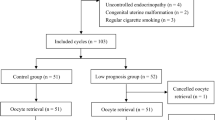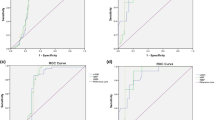Abstract
The aim of this study was to determine whether the bone-morphogenetic proreins-2 (BMP-2) or-7 (BMP-7) levels in follicular fluid (FF) are associated with success in oocyte fertilization during assisted reproductive technology (ART) treatment. Twenty-four cycles in 24 patients who underwent oocyte retrieval in Sugiyama clinic were included in this retrospective study. The patients were divided into two groups according to the success or failure of fertilization. FF samples were obtained from a single follicle in each patient, and the levels of BMP-2, BMP-7, Anti-Müllerian hormone (AMH), estradiol and progesterone from FF were measured, and evaluated in relation to the ART outcomes. The BMP-2 levels correlated positively with the AMH levels in FF (r 2 = 0.4928), but there was no statistically significant difference between BMP-7 and AMH levels. The BMP-2 and BMP-7 levels had no relation with either progesterone or estradiol levels, but BMP-2 levels in the fertilized group were significantly higher than those in the unfertilized group (P < 0.05). The BMP-2 levels in FF positively correlated with the AMH levels in FF, and those in the fertilized group were significantly higher than in the unfertilized group. Therefore, the BMP-2 levels in FF could be a predictive marker for fertilization.
Similar content being viewed by others
References
Velde ER, Pearson PL. The variability of female reproductive aging. Hum Reprod 2002; 8: 141–54.
Broekmans FJ, Knauff EA, te Velde ER, Macklon NS, Fauser BC. Female reproductive ageing: current knowledge and future trends. Trends Endocrinol Metab 2007; 18: 58–65.
Gustofson RL, Stevens J, Minjarez DA, Surrey ES, Schoolcraft WB. O-173: Serum anti-mullerian hormone (AMH) and antral follicle count (AFC) are better predictors of embryo quality and blastocyst formation than patient age and follicle stimulating hormone (FSH). Fertil Steril 2008; 86 (Suppl 2): S74.
Jayaprakasan K, Campbell B, Hopkisson J, Johnson I, Raine-Fenning N. A prospective, comparative analysis of anti-Müullerian hormone, inhibin-B, and threedimensional ultrasound determinants of ovarian reserve in the prediction of poor response to controlled ovarian stimulation. Fertil Steril 2010; 93: 855–64.
Lekamge DN, Barry M, Kolo M, Lane M, Gilchrist RB, Tremellen KP. Anti-Müllerian hormone as a predictor of IVF outcome. Reprod Biomed Online 2007; 14: 602–10.
Takahashi C, Fujito A, Kazuka M, Sugiyama R, Ito H, Isaka K. Anti-Müllerian hormone substance from follicular fluid is positively associated with success in oocyte fertilization during in vitro fertilization. Fertil Steril 2008; 89: 586–91.
Shimasaki S, Moore RK, Otuka F, Erickson GF. The bone morphgenetic protein system in mammalian reproduction. Endocr Rev 2004; 25: 72–101.
Shimasaki S, Moore RK, Erickson GF, Otuka F. The role of bone morphogenetic proteins in ovarian function. Reprod Suppl 2003;61: 323–7.
Findlay JK, Drummond AE, Dyson ML, Baillie AJ, Robertson DM, Ethier JF. Recruitment and development of the follicles; the roles of the transforming growth factor-β superfamily. Mol Cell Endocrinol 2002; 191: 35–43.
Bondestam J, Kavio-oja N, Kallio J et al. Engagement of activin and bone morphogenetic protein signaling pathway Smad proteins in the induction of inhibin B production in ovarian granulose cells. Mol Cell Endocrinol 2002; 195: 79–88.
Moore RK, Otsuka F, Shimasaki S. Molecular basis of bone morphogenetic protein-15 signaling in granulose cells. J Biol Chem 2003; 278: 304–10.
Sugiyama R, Nakagawa K, Nishi Y, Ezaki K, Sugiyama R, Inoue M. The dilemma faced by patients who undergo single embryo transfer. Reprod Biol Med 2009; 8: 33–7.
Nakagawa K, Ohgi S, Kojima R et al. Reduction of perifollicular arterial blood flow resistance after hCG administration is a good indicator of the recovery of mature oocytes in ART treatment. J Assist Reprod Genet 2006; 23: 433–8.
Nakagawa K, Yamano S, Moride N, Yamashita M, Yoshizawa M, Aono T. Effect of activation with Ca ionophore A23187 and puromycin on the development of human oocytes that failed to fertilize after intracytoplasmic sperm injection. Fertil Steril 2001; 76: 148–52.
Shimasaki S, Zachow RJ, Li D et al. A functional bone morphogenetic protein system in the ovary. Proc Natl Acad Sci USA 1999; 96: 7282–7.
Erickson GF, Shimasaki S. The spatiotemporal expression pattern of the bone morphogenetic protein family in rat ovary cell types during the estrous cycle. Reprod Biol Endocrinol 2003; 1: 9.
Glister C, Kemp CF, Knight PG. Bone morphogenetic protein (BMP) ligands and receptors in bovine ovarian follicle cells: actions of BMP-4, -6 and -7 on granulose cells and differential modulation of Smad-1 phosphorylation by follistation. Reproduction 2004; 127: 239–45.
Eppig JJ. Oocyte control of ovarian follicular development and function in mammals. Reproduction 2001; 122: 829–38.
Matzuk MM, Burns KH, Viveiros MM, Eppig JJ. Intercellular communication in the mammalian ovary: oocytes carry the conversation. Science 2002; 296: 2178–80.
Inagaki K, Otuka F, Miyoshi T et al. p38-mitogen-activated protein kinase stimulated steroidogenesis in granulosa cell-oocyte coculture: role of bone morphogenetic proteins 2 and 4. Endocrinology 2009; 150: 1921–30.
Miyoshi T, Otsuka F, Inagaki K et al. Differential regulation of steroidogenesis by bone morphogenetic proteins in granulosa cell: involvement of extracellularly regulated kinase signalling and oocyte actions on follicle-stimulating hormone-induced estrogen production. Endocrinology 2007; 148: 337–45.
Author information
Authors and Affiliations
Corresponding author
Rights and permissions
About this article
Cite this article
Sugiyama, R., Fuzitou, A., Takahashi, C. et al. Bone morphogenetic protein 2 may be a good predictor of success in oocyte fertilization during assisted reproductive technology. Hum Cell 23, 83–88 (2010). https://doi.org/10.1111/j.1749-0774.2010.00088.x
Received:
Accepted:
Issue Date:
DOI: https://doi.org/10.1111/j.1749-0774.2010.00088.x




